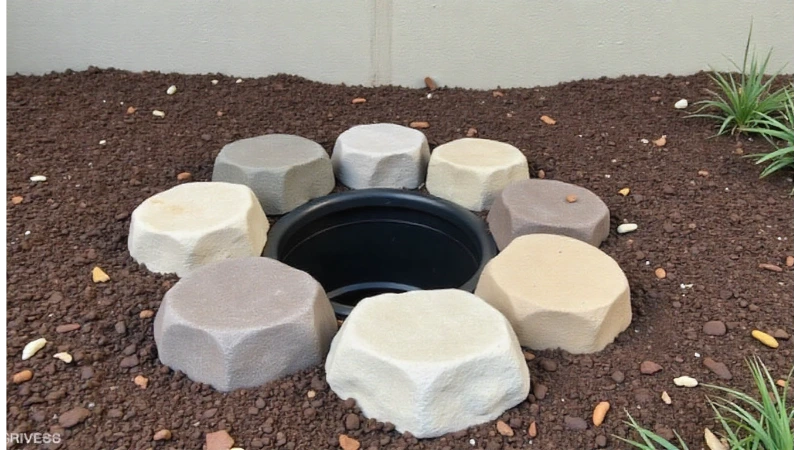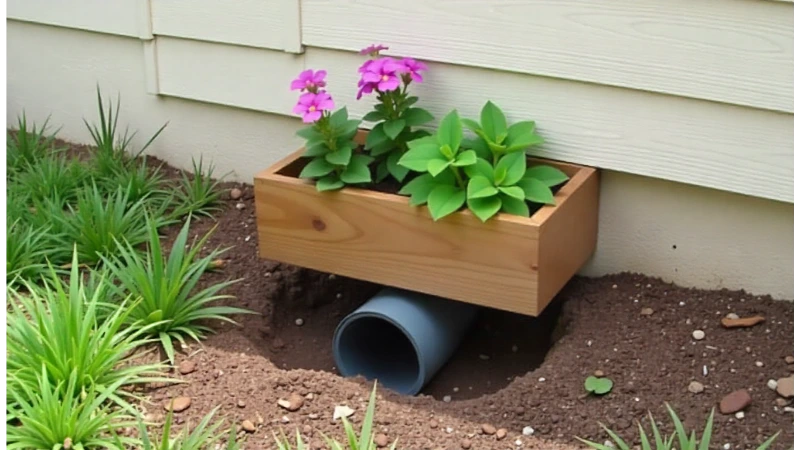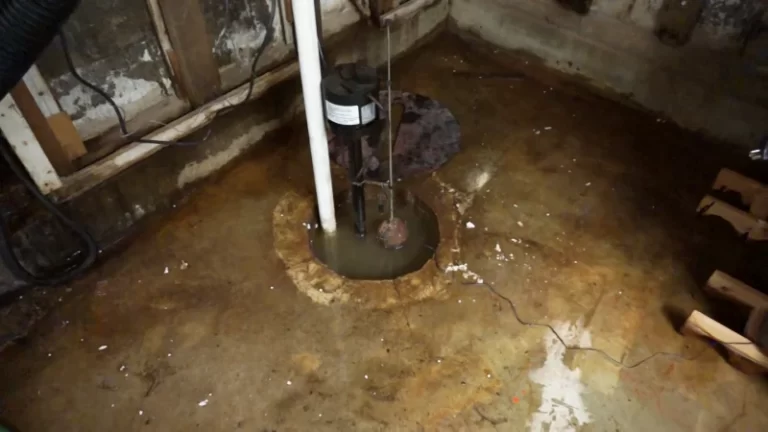Ugly Sump Pump Pipe? 15 Creative Ways to Hide It Now
A sump pump is your basement’s unsung hero, tirelessly working to prevent flooding and water damage. But let’s face it: the discharge pipe that runs across your yard is anything but heroic in appearance. This unsightly but necessary component can disrupt your landscaping, create a tripping hazard, and detract from your home’s curb appeal.
You’re not alone in wondering how to solve this common problem. Many homeowners struggle with that conspicuous PVC pipe snaking its way from the foundation. The good news is that you don’t have to choose between a dry basement and a beautiful yard. There are numerous clever and effective ways to conceal it.
You'll Learn About
Why Hiding Your Sump Pump Discharge Pipe is a Smart Move
The primary function of a sump pump discharge pipe is to carry water a safe distance away from your home’s foundation, typically at least 10 to 20 feet. This prevents the water from seeping back into the soil and re-entering your basement, which would cause the sump pump to overwork and potentially fail. While its function is critical, its form leaves much to be desired.
Leaving the pipe exposed can lead to several issues beyond just aesthetics. It’s susceptible to damage from lawnmowers, foot traffic, and UV rays. In colder climates, an exposed pipe is more likely to freeze, causing blockages that can lead to a flooded basement. Hiding the pipe not only improves your landscape’s look but also protects this vital part of your waterproofing system.
Understanding the Challenge: Functionality Meets Aesthetics
Before diving into solutions, it’s crucial to understand that any concealment method must not interfere with the pipe’s function. The primary goal is to allow water to flow freely and unobstructed away from your house. This means avoiding sharp bends, ensuring a proper downward slope, and preventing blockages from debris or ice. Any solution that compromises drainage is not a solution at all.
It’s also essential to be aware of local codes and regulations. Some municipalities have specific rules about where and how sump pump water can be discharged. Before beginning any major project, like connecting to a storm drain, check with your local building department to ensure compliance.

15 Creative Solutions to Hide Your Sump Pump Discharge Pipe
Ready to reclaim your yard’s beauty? Here are 15 creative and practical solutions, ranging from simple DIY fixes to more involved landscaping projects. These ideas will help you seamlessly blend that pipe into your outdoor space.
1. The Simplest Fix: Paint it to Blend In
One of the easiest and most cost-effective methods is to simply camouflage the pipe with paint. Choose a color that matches your home’s exterior, foundation, or surrounding landscape. A green or brown hue can make the pipe virtually disappear against grass or mulch.
Before painting, make sure to clean the PVC pipe thoroughly to remove any dirt or grime. Use a spray paint designed for plastic to ensure proper adhesion and durability against the elements. This quick fix can make a surprising difference with minimal effort.
2. Bury the Pipe: The Out-of-Sight Solution
For a truly seamless look, burying the discharge pipe is an excellent option. This involves digging a trench from your house to a suitable drainage point in your yard. The pipe should be buried below the frost line if you live in a cold climate to prevent freezing.
Ensure the trench has a consistent downward slope (at least a 1/8-inch drop per foot) to allow gravity to do its work. It’s also wise to install a protective cap or a pop-up emitter at the end to prevent debris and critters from getting inside. While more labor-intensive, burying the pipe is a permanent and highly effective solution. However, be aware of potential issues like clogging, which can be harder to address when the pipe is underground.
3. Create a Decorative Rock Bed or Gravel Trench
A rock bed or a dry creek bed can be a beautiful and functional way to hide the pipe. This method involves creating a shallow trench along the pipe’s path and filling it with decorative river rocks, gravel, or pebbles. This not only conceals the pipe but also helps with water dispersion and prevents soil erosion at the discharge point.
You can line the trench with landscape fabric to prevent weed growth and keep the rocks from sinking into the soil. This solution adds a professional-looking hardscape element to your yard while cleverly hiding the drainage line. It’s a popular choice for its aesthetic appeal and dual functionality.
4. Plant a Natural Barrier with Shrubs and Grasses
Harness the power of nature by using plants to create a screen. Strategically planting dense shrubs, ornamental grasses, or evergreen bushes can effectively hide the pipe from view. Choose plants that will grow tall and full enough to provide year-round coverage.
When selecting plants, consider their mature size and root systems to avoid interfering with the pipe or your home’s foundation. Leave enough space around the pipe for air circulation and access for maintenance. Evergreens like boxwoods or arborvitae are excellent choices for consistent concealment.
5. Build a Small Retaining Wall or Planter Box
Integrate the discharge pipe into a landscape feature by building a low retaining wall or a raised planter box. The pipe can be run behind or through the structure, completely hiding it from sight. This adds dimension and interest to your yard while serving a practical purpose.
This is a great opportunity to create a multi-level garden or a defined edge for a flower bed. A similar issue can arise when your baseboard heat not working upstairs is due to hidden pipe problems, emphasizing the need for accessible design.
6. Utilize a Faux Rock Cover
For a quick and surprisingly realistic solution, use a hollow, lightweight faux rock cover. These are designed to look like real boulders and can be placed directly over the end of the discharge pipe or other unsightly utility items. They come in various shapes, sizes, and colors to match your landscape.
Faux rock covers are durable, weather-resistant, and easy to move when you need to access the pipe. This is an ideal, low-effort solution for concealing the most visible part of the system—the outlet.
7. Create a Purposeful Rain Garden
Turn your drainage area into an eco-friendly and beautiful rain garden. A rain garden is a shallow depression planted with water-loving native plants. Direct the discharge pipe to empty into this garden, where the water will be absorbed by the plants and soil.
This not only hides the end of the pipe but also creates a miniature ecosystem that can attract butterflies and birds. It’s a sustainable solution that manages water runoff effectively while adding a unique feature to your yard.
8. Install a Dry Well System
A dry well is an underground structure that collects and gradually disperses water into the surrounding soil. The discharge pipe is connected to this buried, perforated tank. This method completely hides the pipe and the discharged water, preventing soggy spots in your yard.
Installing a dry well is a more involved project and may require professional help, but it’s one of the most effective ways to manage large volumes of water invisibly. It promotes groundwater recharge and reduces strain on storm drains.

9. Use Decorative Enclosures or Screens
A small, decorative fence panel, a piece of lattice, or a custom-built wooden box can effectively screen the pipe from view. This is a great option for pipes that run along the side of a deck, patio, or your house foundation. You can paint or stain the enclosure to match your home’s exterior.
Ensure any enclosure has adequate ventilation and allows for easy access for maintenance. This method is highly customizable and can be adapted to fit your specific landscape design.
10. Integrate it into a Water Feature
For the truly ambitious, why not turn the discharged water into a landscape highlight? The pipe can be designed to feed a small pond, waterfall, or bubbling rock feature. The continuous flow from the sump pump can create a dynamic and visually appealing element in your garden.
This solution requires careful planning and a pump that runs with some regularity. However, it is the ultimate way to transform a functional necessity into a stunning focal point.
11. Conceal with a Hose Pot or Planter
A large, decorative hose pot or an empty planter can be placed over the end of the discharge pipe. You may need to cut a hole in the back for the pipe to enter. This is a simple, non-permanent solution that adds a decorative touch while hiding the outlet.
This works best for pipes that terminate in a garden bed or near a patio. It’s a quick fix that can be implemented in minutes. In homes with complex systems, just as you’d need to troubleshoot a carrier furnace code 12, ensuring all parts are accessible is key.
12. Run the Pipe Under a Deck or Walkway
If your landscaping plans include a new deck, patio, or walkway, plan the discharge pipe’s route to run underneath it. This completely hides the pipe along its entire length. Proper planning is essential to ensure the pipe is correctly sloped and accessible if needed.
For existing structures, it may be possible to carefully route the pipe beneath them. This is an elegant solution that keeps the pipe out of sight and out of mind.
13. Use a Pop-Up Emitter
A pop-up drain emitter is a clever device that connects to the end of a buried discharge line. The emitter sits flush with the lawn, and the lid “pops up” from water pressure to release the water, then retracts when the flow stops. This keeps the outlet hidden and prevents it from being a tripping hazard or damaged by a lawnmower.
Pop-up emitters provide a clean, professional finish to a buried drainage system. They are an excellent final touch that ensures the termination point is as discreet as the rest of the hidden pipe.
14. Build a False Wall or Barrier
Indoors or outdoors, a false wall can conceal the pipe. Outdoors, this could be a small section of stone veneer or siding that matches your home, creating a deliberate architectural feature that hides the pipework behind it. It’s a creative way to blend the pipe into your home’s structure.
This is a more permanent solution that requires some construction skills but offers a completely integrated look. Much like addressing hydro gear zt-3100 problems requires a specific approach, this solution is tailored for a seamless aesthetic.
15. Use Landscape Edging and Mulch
A simple yet effective technique is to create a mulched bed along your foundation where the pipe runs. Use landscape edging to define the area, lay down the pipe, and cover it with a thick layer of mulch. The pipe will be hidden just below the surface.
This method is easy to install and maintain. The mulch can be easily moved if you need to access the pipe, and the defined garden bed adds a manicured look to your landscaping.
Comparison of Concealment Methods
To help you decide which solution is best for you, here is a comparison of some of the most popular options.
| Solution | Cost | Difficulty | Aesthetic Appeal | Maintenance |
|---|---|---|---|---|
| Painting the Pipe | Low | Easy | Good | Low |
| Burying the Pipe | Moderate | High | Excellent | Low (if installed correctly) |
| Rock Bed/Trench | Moderate | Moderate | Excellent | Low |
| Planting Shrubs | Low-Moderate | Easy | Excellent | Moderate (trimming) |
| Faux Rock Cover | Low | Easy | Very Good | Low |
| Rain Garden | Moderate | Moderate | Excellent | Moderate (plant care) |
Final Thoughts: Protect Your Home, Perfect Your Yard
An exposed sump pump discharge pipe doesn’t have to be a permanent blemish on your landscape. With a little creativity, you can implement a solution that not only hides the pipe but also enhances your yard’s overall appeal. Whether you choose a simple coat of paint or a beautifully integrated dry creek bed, the key is to ensure your chosen method doesn’t compromise the vital function of your sump pump system.
By carefully considering your budget, DIY skills, and desired aesthetic, you can select the perfect strategy from these 15 creative solutions. You’ll gain peace of mind knowing your basement is protected while enjoying a beautiful, polished outdoor space free of unsightly pipes.

